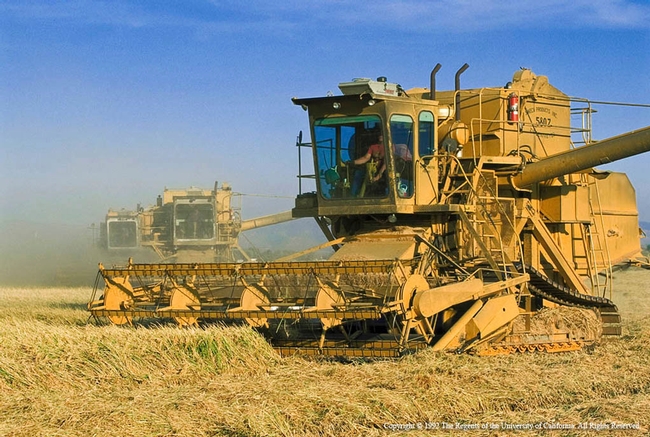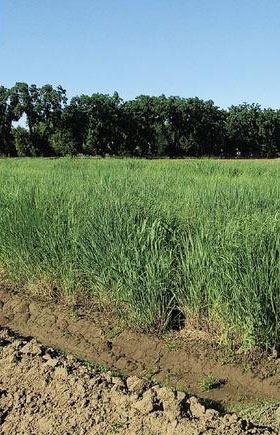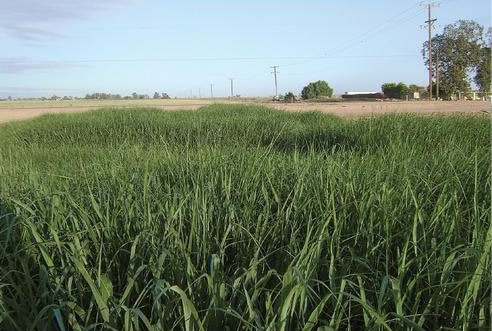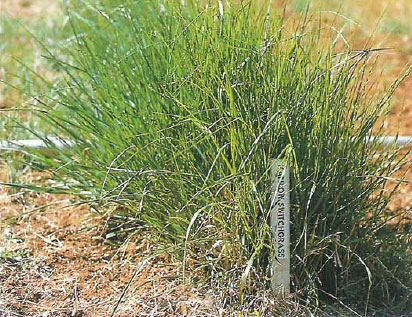Posts Tagged: biofuel
Firm partners with Kaffka to develop biofuel
The California Energy Commission has awarded Biodiesel Industries of Ventura a $2 million grant for research and development of biodiesel fuel.
A key issue with biofuel production has been the need for inexpensive feedstocks that do not compete with agricultural land use or food production.
To develop low-impact feedstock suitable for underutilized land, the company is partnering with Stephen Kaffka, UC Cooperative Extension specialist in the Department of Plant Sciences at UC Davis.
Kaffka plans to study the viability of oilseed crops for biofuel in test plots at UC Davis and in Salinas, the Imperial Valley and Five Points in the Central Valley. To test the feedstock for commercial farming use, Kaffka will plant the crops at John Diener's 5,400-acre Red Rock Ranch in the Central Valley, which produces 40 conventional and organic crops.
“I will do the agronomic work on new oilseed crops for my part of the grant, but there are a large number of other activities in the grant as well,” Kaffka said. “My goal is to be of service in support of emerging bioenergy groups in California.”
“We are very pleased with the work Dr. Kaffka has been doing, and look forward to working with him to develop the potential for new bioenergy crops in California,” said Russell Teall, president and founder of Biodico, the parent company of Biodiesel Industries of Ventura.
Rice growers optimistic; seeking biomass growers
The (Marysville) Appeal-Democrat checked in on the rice harvest which started recently, with an article by reporter Ashley Gebb. USDA reports that harvested acreage for rice in California is up 6 percent this year, to 588,000 acres; in 2010, Yuba and Sutter counties had approximately 154,000 acres planted in rice. The reporter talked to Chris Greer, UC Cooperative Extension farm advisor for Sutter-Yuba and Colusa counties, about what this summer's cooler weather means for the rice harvest. "Overall things look pretty good from a yield standpoint," he told the reporter. "We will have to see what the numbers come out. From what we are seeing, we are pretty optimistic on the prospects."
Harvesting jet fuel
Kathy Johnston, (San Luis Obispo) New Times
Reporter Kathy Johnston examined both government and grower interest in camelina sativa, an oilseed crop that can be used in jet fuel. Growers interested in camelina can sign up for USDA's Biomass Crop Assistance Program, the deadline for which has been extended. The reporter talked with Steve Kaffka, UC Cooperative Extension agronimist in Davis and director of the California Biomass Collaborative, who is seeking cooperating growers for trial plantings of camelina under local conditions this winter. “It hasn’t been adapted specifically for California. We’re trying to figure out what conditions it likes, the range of rainfall and soil types where it might be suitable in San Luis Obispo County,” Kaffka told the reporter.
She also talked to Royce Larsen, UC Cooperative Extension natural resources advisor in San Luis Obispo county, who explained that though meetings about the crop have been well attended, no San Luis Obispo growers have signed up for the program yet. “A lot of people showed up [at a meeting about camelina in Templeton] with great interest, but they left, I think, a little downhearted,” Larsen told the reporter. “The bottom line is it’s too new, with too many unknowns for people to want to jump on board and give this a try."
(Though this article is about San Luis Obispo county, other California counties included in this project area are Butte, Colusa, Fresno, Glenn, Kern, Kings, Madera, Merced, Riverside, Sacramento, San Joaquin, Solano, Stanislaus, Riverside, Tehama, Tulare and Yolo, according to an article on the California Ag Network website.)
Switchgrass could become high-yielding biofuel crop
California must continually increase its use of renewable fuels to meet mandated reductions in greenhouse gas emissions (GHG). The state's historic Global Warming Solutions Act of 2006 (AB32) requires that alternative fuels displace 6 percent of gasoline and diesel use now, and 9 percent by 2012. The number goes up to 11 percent in 2017 and 26 percent in 2022.
California has been meeting these goals by importing millions of gallons of ethanol: 80 percent of the supply is corn ethanol from the Midwest, 12 percent is sugarcane ethanol from Brazil, and the rest is ethanol from corn grown here. By 2012, demand for ethanol fuel will rise to 1.62 billion gallons per year. If California does not increase its production of corn for ethanol, it will need to import 95 percent of that amount.
In the search for a better alternative, scientists have been investigating conversion of cellulose to ethanol. Technical challenges remain, but cellulose offers a potentially abundant feedstock for biofuels.
One of the plants seen as a possible dedicated biofuel crop in the United States is switchgrass. It is about 40 percent cellulose and grows widely in the Midwest and the South. However, it is not native to California and has not been produced here.
Recent studies by UC Davis scientists are the first ever to report tests of different switchgrass ecotypes in California, - and are published in the current California Agriculture journal.
Scientists evaluated the productivity of the two main ecotypes of switchgrass, lowland and upland, under irrigated conditions across four diverse California ecozones — from Tulelake in the cool north to warm Imperial Valley in the south.
”It is important to know how much biomass can be produced in the state before deciding to pursue cellulosic ethanol," says UC Davis plant scientist Gabriel Pedroso. "California has very diverse climatic regions, which affect the adaptability and productivity of switchgrass.”
Because it is a deep-rooted perennial grass, switchgrass promotes soil conservation. It stores carbon in its root system, and makes efficient use of water by virtue of its C4 photorespiration.
Switchgrass requires an establishment year.
"In the second year of production, the lowland varieties grown in the warm San Joaquín and Imperial valleys yielded up to 17 tons per acre of biomass, roughly double the biomass yields of California rice or maize," Pedroso said.
Because it can be used both as forage and as a biofuel crop, switchgrass may be well suited to California, a state with a large livestock industry and higher ethanol consumption than any other.
While the field trial results are promising, commercial, large-scale conversion processes for cellulose to sugars and fuels are just beginning to be demonstrated.
Cellulose is a complex matrix of smaller sugar molecules and fibrous material in plant cell walls. It is the principal structural component of all plant material, including residues and organic materials in municipal solid waste. If it were possible to efficiently break it down into simple sugars, if would become a productive source of ethanol, and would significantly reduce GHG.
USDA official promotes renewable fuel infrastructure
A USDA official was in Oakland yesterday to promote the development of renewable fuel infrastructure in the United States, according to a news release from Propel Fuels. The federal agency plans to fund the build-out of 10,000 renewable fuel pumps across the nation in the next five years.
Judith Canales, administrator of USDA's Rural Business and Cooperative Programs, spoke at a press conference held at a gas station where customers can purchase E85 Flex Fuel and biodiesel from Redwood City-based Propel Fuels.
A story produced by KGO-TV in San Francisco said high fuel prices came at a perfect time for Propel, whose biofuel business is booming.
"What we are trying to do is focus on fuels that are domestically made, and fuels that could contribute to American jobs and reduce our dependence on foreign oil," Propel executive Jim Iacoponi told KGO reporter Wayne Freedman.
Most American-made biofuel is produced with corn. Corn is high in starch, but low in sugars, making it less efficient for making fuel than foreign sugar cane. But high U.S. tariffs make corn a viable alternative.
In the news story, UC Berkeley physicist Richard Muller attributed some of the interest in corn to presidential politics.
"Well, it's Iowa," Muller said. "In order to win the Iowa caucuses go to Iowa and promise they will support corn ethanol."
At the news conference, Canales said corn will only be part of the solution.
In the U.S., there are more than 20 million vehicles (more than 1 million of those in California) capable of running on renewable fuels, but the majority do not have access to these fuels. Propel has plans to build 75 additional stations in the Bay Area and Sacramento, as well as in new markets later this year, the news release said.

USDA's Judith Canales fuels a CalTrans vehicle that runs on biofuel.
Green energy may generate more greenbacks for farmers
California’s role as an emerging world leader in the development of green energy technologies offers the state’s farmers the opportunity to diversify their cropping systems and increase their income.
Sacramento lawmakers have given the California Energy Commission an annual budget of $100 million to support the development of alternative and renewable low-carbon fuels. In addition, the State Alternative Fuels Plan set goals of reducing petroleum dependence by 15 percent and increasing alternative fuels use by 20 percent by 2020. These efforts are meant to help meet the growing fuel demands of the world population while reducing greenhouse gas emissions in California to 1990 levels.
“With the new mandates, there are new opportunities for using agricultural waste and dedicated energy crops for biofuels, but we’re not yet sure exactly what form it will take,” said UC Cooperative Extension alfalfa specialist Dan Putnam. “I would always encourage growers to experiment with the crop, but I wouldn’t jump in whole hog unless I had a buyer lined up.”
Switchgrass is a potential biofuel crop.
U.S. ethanol production in January 2010 was 818,000 barrels per day, according to the U.S. Energy Information Administration. The United States uses about 20 million barrels of oil per day. If the EPA allows up to 15 percent ethanol blends for all vehicles, then the 10 million barrels per day of oil used by cars and trucks could allow ethanol and biofuels to make up 1.5 million barrels per day.
Cellulosic biomass is the only known resource for the sustainable production of liquid transportation fuels on a large scale and at low costs, according to UC Riverside environmental engineer C. W. Wyman. Cellulosic biomass includes agricultural residues such as corn stems and leaves, forestry residues such as sawdust and paper, landscape waste, herbaceous plants such as switchgrass and sorghum, and woody plants such as poplar trees.
Since a dry ton of cellulosic biomass could provide about three times as much energy as a barrel of petroleum, the cellulosic biomass would have three times the value as a barrel of petroleum. That means cellulosic biomass would be worth about $200 per dry ton when crude oil sells at $65 per barrel.
“To utilize this abundant resource, we must develop low-cost technologies for transforming biomass into fuels that can compete with petroleum,” Wyman wrote in a California Agriculture article “Cellulosic biomass could meet California’s transportation fuel needs.”
Current and potential biomass crops include the grasses switchgrass and miscanthus, other perennial grasses, plus high biomass sorghum, alfalfa and other crops.
Across California, University of California scientists are studying potential biofuel crops. Putnam has four research trials under way, testing varieties from Ceres and Mendel Biotechnology, Inc. He said switchgrass and miscanthus the top contenders so far in his trials.
“The yields of switchgrass under irrigation have been quite high,” Putnam said. “It is an efficient crop for converting solar energy into biomass under warm weather condition.”
Switchgrass does have relatively high water needs. Putname said scientists are looking into whether the crop can be grown under deficit irrigation to save water and still produce the biomass.
“The key issue with biofuels is not necessarily the total water requirement, but the water use efficiency and amount of biomass produced per unit of water,” Putnam said. “Even if a crop has high water use, if it produces a large amount of biomass, it may still be the best option.”
Steve Kaffka and UC Cooperative Extension advisors are involved in research on winter annual oilseeds such as canola, camelina and meadowfoam as potential biofuel feedstock crops.
“Recent economic modeling we have done suggests that at current market prices, canola is a competitive crop in California, but outlets have not yet developed for the seed,” Kaffka said. “Currently, petroleum prices are too low to support the use of canola for biofuel feedstocks, but that is changing rapidly. “
The director of the UC Kearney Research and Extension Center, Jeff Dahlberg, sees opportunities for California production of sorghum as a biofuel crop.
"Sorghum is one of the few crops that span all the different renewable fuel options," he said. "You can use the grain to convert into ethanol. We have sweet sorghum, a specialty sorghum which is very similar to sugar cane. You can press the juice out and convert it into ethanol. And, we can produce a lot of biomass."
Dahlberg previously served as research director for the National Sorghum Producers and the research director for the United Sorghum Checkoff Program in Lubbock, Tex. He currently is lead investigator on a $984,000 U.S. Department of Energy grant to study the composition of sorghum and its potential for cellulosic conversion to biofuel. In addition to continuing this research at Kearney, Dahlberg is interested in developing a center for on-farm green technologies at the Central California research station.






